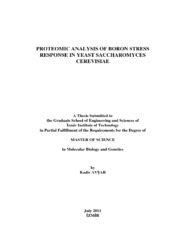Please use this identifier to cite or link to this item:
https://hdl.handle.net/11147/3131Full metadata record
| DC Field | Value | Language |
|---|---|---|
| dc.contributor.advisor | Koç, Ahmet | en |
| dc.contributor.author | Avşar, Kadir | - |
| dc.date.accessioned | 2014-07-22T13:50:56Z | - |
| dc.date.available | 2014-07-22T13:50:56Z | - |
| dc.date.issued | 2011 | en |
| dc.identifier.uri | http://hdl.handle.net/11147/3131 | - |
| dc.description | Thesis (Master)--Izmir Institute of Technology, Molecular Biology and Genetics, Izmir, 2011 | en |
| dc.description | Includes bibliographical references (leaves: 28-31) | en |
| dc.description | Text in English; Abstract: Turkish and English | en |
| dc.description | ix, 31 leaves | en |
| dc.description.abstract | Boron is a versatile element distributed in every part of the environment but most of its deposit reserves are localized in a few countries, Turkey being one of the most prominent. Boron is known to be an essential micronutrient for plants and some animals. Like any other essential element it has toxicity in high concentrations. Herein the mechanism of toxicity and the elements of the boron stress response were investigated in Saccharomyces cerevisiae with a proteomics approach. Boron is believed to have played a role in the evolution of life on earth. It has strongly electrophile organic compounds, the most important physiological form being boric acid. Boric acid has a capacity to bind cis-located hydroxl groups and some amino groups. Some of these groups are located at the active sites of some enzymes and at the carbohydrates with five-membered furanose rings. The riboses of some metabolically important molecules like S-adenosyl methionine, diadenosine phosphate family members and 3'end of RNAs are prone to be affected. The yeast cells subjected to boron in this study expressed higher amounts of carbohydrate metabolic enzymes, proteins involved in protein synthesis, protein folding and catabolism, redox homeostasis and nucleotide synthesis. All of these proteins are common to metal stress responses in yeasts. Some of them involve in other stress responses like peroxide, salt or herbicide stresses showing complex interplay between responses. | en |
| dc.language.iso | en | en_US |
| dc.publisher | Izmir Institute of Technology | en |
| dc.rights | info:eu-repo/semantics/openAccess | en_US |
| dc.subject.lcsh | Saccharomyces cerevisiae--Effect of of stress on | en |
| dc.subject.lcsh | Proteomics | en |
| dc.subject.lcsh | Boron | en |
| dc.subject.lcsh | Yeast | en |
| dc.title | Proteomic analysis of boron stress response in yeast saccharomyces cerevisiale | en_US |
| dc.type | Master Thesis | en_US |
| dc.institutionauthor | Avşar, Kadir | - |
| dc.department | Thesis (Master)--İzmir Institute of Technology, Molecular Biology and Genetics | en_US |
| dc.relation.publicationcategory | Tez | en_US |
| item.grantfulltext | open | - |
| item.cerifentitytype | Publications | - |
| item.languageiso639-1 | en | - |
| item.openairecristype | http://purl.org/coar/resource_type/c_18cf | - |
| item.fulltext | With Fulltext | - |
| item.openairetype | Master Thesis | - |
| Appears in Collections: | Master Degree / Yüksek Lisans Tezleri Sürdürülebilir Yeşil Kampüs Koleksiyonu / Sustainable Green Campus Collection | |
Files in This Item:
| File | Description | Size | Format | |
|---|---|---|---|---|
| T000938.pdf | MasterThesis | 541.04 kB | Adobe PDF |  View/Open |
CORE Recommender
Page view(s)
134
checked on Jul 29, 2024
Download(s)
130
checked on Jul 29, 2024
Google ScholarTM
Check
Items in GCRIS Repository are protected by copyright, with all rights reserved, unless otherwise indicated.